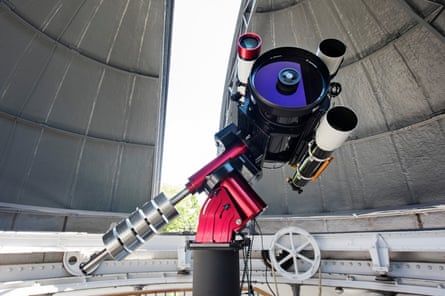Pull on the right ropes and the dome at the Altazimuth pavilion at the Royal Observatory Greenwich swings around and opens up to reveal a thick band of London sky. The Victorian building is about to emerge from a major refurbishment and inside the dome sits the main attraction: a cutting-edge telescope that will make Greenwich a working observatory for the first time in 60 years.
The installation of the Annie Maunder Astrographic Telescope (Amat) has staff at Greenwich palpably excited. Over the obligatory banging of builders at work, Brendan Owens and Tom Kerss, both astronomers at the site, admit that they have been working late, very late, to put the kit through its paces. If they are tired from being up all hours, they do not let it show. “It’s a little bit addictive,” Owens says.
Named after one of the first women to work at Greenwich, the £50,000 telescope is arguably the most impressive that can be bought off the shelf. It has the power to capture high magnification still and moving images of the sun, moon and the planets of the solar system. Farther afield, it will study the chemical makeup of nebulae, those interstellar clouds of dust and gas, and watch alien worlds such as the massive Jupiter-like 51 Pegasi b loop around their parent stars.
The images and readings taken by the telescope will support astrophysics research and be shared with schools and the public through live-streams, the Peter Harrison Planetarium next door, and workshops held at the observatory. To help out with the running of the telescope the observatory is looking to teams of volunteers, many of whom are likely to come from local enthusiasts’ clubs. “We want to make use of every clear night we get,” said Kerss.
For the moment the five-metre wide dome is manually operated: rotated and opened by ropes and pulleys. But there are plans to retrofit the structure with motors and electronics so the telescope and dome can move in unison. This would allow the telescope to follow objects over hours as they move across the night sky, and even track the International Space Station as it hurtles overhead at 17,500mph.
“The automation work will be essential if we want to do more research projects,” said Owens. “It’s either that or we get someone who is extremely dedicated with the ropes.”
Charles II founded the Royal Observatory in Greenwich in 1675 with the aim of mapping the precise locations of stars and so improve the Navy’s maritime navigation. But since 1957, when its instruments and research were moved to Herstmonceux in East Sussex, the London site has been a museum and centre for public outreach. With the new telescope in place, research is back on the agenda.
When the Altazimuth pavilion opens to the public in August, the exhibition space on the ground floor beneath the telescope will tell the stories of Annie Maunder and her husband Walter. Annie joined the observatory in 1891 after passing her exams at Cambridge University with flying colours. Back then, Cambridge did not award women degrees, but Annie’s clear mathematical skills earned her one of the few paid jobs in astronomy that were available to women.

Annie worked on solar observations, a department run by Walter Maunder, and when the two married in 1895, she had to resign her post due to restrictions that barred married women from working in public service. The pair continued to collaborate though, writing books together, setting off on expeditions to observe solar eclipses, and mapping sunspots in work that established the connection between the sun’s activity and Earth’s climate.
Noting that the Royal Astronomical Society did not allow women members at the time, Walter Maunder co-founded the British Astronomical Association, which explicitly did welcome women, and people from all backgrounds. Annie went on to edit the association’s journal for 35 years.
Brushing aside a piece of bread that appeared to have fallen through the open dome from a passing bird, the astronomers at Greenwich explain how Amat is actually a cluster of four separate instruments. The largest, a 14-inch reflector, can take high resolution images of the sun, moon and planets, picking out features such as Jupiter’s swirling red storm, or dark patches on Neptune near the edge of the solar system. A second instrument is dedicated to observing the sun, while a third that resembles a Tommy gun has a circular magazine of filters which can be swapped automatically to view distant nebulae at different wavelengths of light. The fourth is a general purpose telescope.
The cluster of telescopes and the refurbishment of the pavilion were paid for by grants, museum members and patrons, and public donations that together raised more than £150,000 for the project. The first images released from the telescope reveal the rugged terrain on the waxing gibbous moon and fierce activity in the sun’s atmosphere.
“We’ve just started our adventure,” says Owens. “We want to make Greenwich a functioning observatory and to involve the public with that work. We want to have the best of both worlds.”
